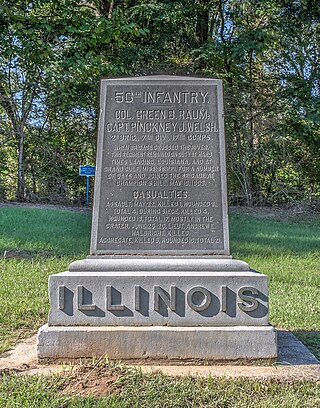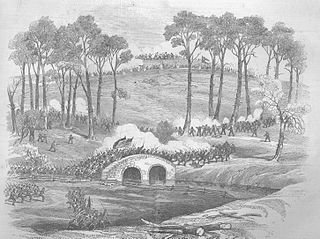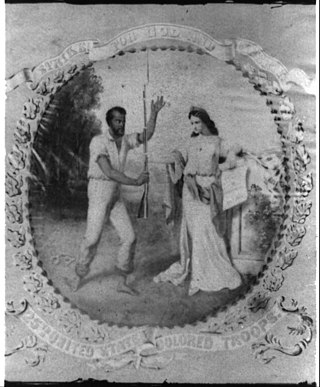Related Research Articles

Sultana was a commercial side-wheel steamboat which exploded and sank on the Mississippi River on April 27, 1865, killing 1,167 people in what remains the worst maritime disaster in United States history.

The Battle of Hatteras Inlet Batteries was the first combined operation of the Union Army and Navy in the American Civil War, resulting in Union domination of the strategically important North Carolina Sounds.

Fort Fisher was a Confederate fort during the American Civil War. It protected the vital trading routes of the port at Wilmington, North Carolina, from 1861 until its capture by the Union in 1865. The fort was located on one of Cape Fear River's two outlets to the Atlantic Ocean on what was then known as Federal Point or Confederate Point and today is known as Pleasure Island. The strength of Fort Fisher led to its being called the Southern Gibraltar and the "Malakoff Tower of the South". The battle of Fort Fisher was the most decisive battle of the Civil War fought in North Carolina.

During the American Civil War, the State of Ohio played a key role in providing troops, military officers, and supplies to the Union army. Due to its central location in the Northern United States and burgeoning population, Ohio was both politically and logistically important to the war effort. Despite the state's boasting a number of very powerful Republican politicians, it was divided politically. Portions of Southern Ohio followed the Peace Democrats and openly opposed President Abraham Lincoln's policies. Ohio played an important part in the Underground Railroad prior to the war, and remained a haven for escaped and runaway slaves during the war years.

SS Valencia was an iron-hulled passenger steamer built for the Red D Line for service between Venezuela and New York City. She was built in 1882 by William Cramp and Sons, one year after the construction of her sister ship Caracas. She was a 1,598-ton vessel, 252 feet (77 m) in length. In 1897, Valencia was deliberately attacked by the Spanish cruiser Reina Mercedes off Guantanamo Bay, Cuba. The next year, she became a coastal passenger liner on the U.S. West Coast and served periodically in the Spanish–American War as a troopship to the Philippines. Valencia was wrecked off Cape Beale, which is near Clo-oose, on the west coast of Vancouver Island, British Columbia, on 22 January 1906. As her sinking killed 100 people, some classify the wreck of Valencia as the worst maritime disaster in the "Graveyard of the Pacific", a famously treacherous area off the southwest coast of Vancouver Island.

The 56th Regiment Illinois Volunteer Infantry was an infantry regiment that served in the Union Army during the American Civil War.

USS General Lyon, originally the De Soto, was recaptured from the Confederate States of America and renamed USS De Soto, and then USS General Lyon, after Brigadier General Nathaniel Lyon.

USS Isaac Smith was a screw steamer acquired by the United States Navy during the American Civil War. She was used by the Union Navy to patrol navigable waterways of the Confederate States of America to prevent the Confederacy from trading with other countries. In 1863, she became the only warship in the American Civil War to be captured by enemy land forces. She then served in the Confederate States Navy as CSS Stono until she was wrecked.
USS Britannia was a steamer captured by the Union Navy during the American Civil War. She was used by the Union Navy as a gunboat and patrol vessel in support of the Union Navy blockade of Confederate waterways.
USS Gemsbok was a bark acquired by the Union Navy during the American Civil War. She was used by the Navy as a gunboat, but, later in the war, she was also used as a collier and as a storeship.
The third USS Union was a heavy (1,114-ton) steamer with a powerful 12-inch rifled gun purchased by the United States Navy during the American Civil War.

The 9th New York Infantry Regiment was an infantry regiment that served in the Union Army during the American Civil War. It was also known as the "Hawkins' Zouaves" or the "New York Zouaves."

George Washington Brush was an American soldier, dentist, physician and politician. He served as a captain of a black company in the 34th Infantry Regiment U.S. Colored Troops in the Union Army during the American Civil War and received the Medal of Honor. After the war he became first a dentist and then a physician. He was elected to the New York State Assembly and then the State Senate. As chairman of the Senate Health Committee he helped establish the State Tuberculosis Sanatorium at Saranac Lake.

The 21st Massachusetts Infantry Regiment was an infantry regiment in the Union Army during the American Civil War. It was organized in Worcester, Massachusetts and mustered into service on August 23, 1861.
The following list is a Bibliography of American Civil War Union military unit histories. More details on each book are available at WorldCat.

The 99th New York Infantry Regiment, the "Union Coast Guard", "Bartlett's Naval Brigade", "Lincoln Divers", or "New York and Virginia Coast Guard", was organized as a naval infantry brigade, but mainly served as an infantry regiment of the Union Army during the American Civil War.
The 20th New York Infantry Regiment, the "Turner Rifles", was an infantry regiment of the Union Army during the American Civil War.

The 25th United States Colored Infantry was an infantry regiment that served in the Union Army during the American Civil War. The regiment was composed of African American enlisted men commanded by white officers and was authorized by the Bureau of Colored Troops which was created by the United States War Department on May 22, 1863.

Ajax was a wooden, propeller-driven steamship built in 1864. She provided logistical support to the Union Army on the Atlantic coast during the American Civil War. After the war she was sent to San Francisco where she provided freight and passenger services between that city and other ports on the Pacific coast. She provided the first scheduled steamship service between the United States and Hawaii.

Western Metropolis was a wooden side-wheel steamship built in 1863. She was chartered by the quartermaster corps of the Union Army during the American Civil War to provide logistical support. As a transport ship, she was unarmed, but nonetheless captured a Confederate blockade runner. After the war, she was in commercial service for another ten years. Notably, she made five trans-Atlantic voyages and brought several thousand immigrants to the United States from Northern Europe. She was idled in 1875, and had her engine removed in 1878. Her ultimate fate is unknown.
References
- ↑ Encyclopedia of Civil War Shipwrecks
- ↑ "Re: steamer General Lyons". www.history-sites.net. Retrieved 2023-10-26.
- ↑ Going Home: The Short Life and Sudden Death of the U.S. Military Transport Steamer General Lyon. ISBN 978-1721118564 (375 pages)
- ↑ "THE GEN. LYON DISASTER.; Complete List of the Passengers and Crew". The New York Times. 1865-04-14.
- ↑ Southern Illinoisan from Carbondale, Illinois · Page 10 Sunday May 16, 1971
- ↑ Survivor Michael Brocket's Story 1908
- The General Lyon Tragedy, Illinois Periodicals Online (a project of Northern Illinois University Libraries).
- 56th Illinois Infantry Regiment History, ILGenWeb (Illinois Genealogy Web Project).
- US Army Transport General Lyon (personal website with additional links).(Site no longer exists)